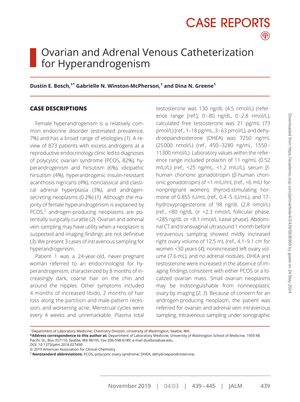TLDR Venous catheterization may help diagnose the cause of female hyperandrogenism when imaging is unclear.
The document discusses the prevalence and causes of female hyperandrogenism, noting that while the majority of cases are due to polycystic ovarian syndrome (PCOS), androgen-producing neoplasms, though rare, can be surgically treated. It highlights the potential use of ovarian and adrenal vein sampling in cases where a neoplasm is suspected but imaging is inconclusive. The document presents three cases, with the first case involving a 24-year-old woman experiencing symptoms of hyperandrogenism, including increased body hair, hair loss, and acne, with elevated levels of plasma total testosterone and dehydroepiandrosterone (DHEA). The summary does not provide the outcomes of the cases or the effectiveness of the venous catheterization technique.
 3 citations
,
June 2016 in “Gynecological Endocrinology”
3 citations
,
June 2016 in “Gynecological Endocrinology” Doctors used a special blood sampling technique to diagnose a woman's rare ovarian tumor that was producing male hormones.
 1540 citations
,
October 2008 in “Fertility and Sterility”
1540 citations
,
October 2008 in “Fertility and Sterility” The report concludes that PCOS is mainly a condition of excess male hormones and its definition may change as new information is discovered.
 947 citations
,
February 2004 in “The Journal of Clinical Endocrinology and Metabolism”
947 citations
,
February 2004 in “The Journal of Clinical Endocrinology and Metabolism” Most women with excess male hormones have Polycystic Ovary Syndrome, and hormonal therapy can improve symptoms but may cause side effects.
 14 citations
,
February 2016 in “Journal of Obstetrics and Gynaecology Research”
14 citations
,
February 2016 in “Journal of Obstetrics and Gynaecology Research” Blood tests are needed to confirm high male hormone levels in women with PCOS, as physical signs alone are not reliable.
 3 citations
,
January 2012 in “Hanyang Medical Reviews”
3 citations
,
January 2012 in “Hanyang Medical Reviews” The document concludes that more research is needed to create suitable diagnostic criteria and understand PCOS in Korean women, and genetics may allow for personalized treatment.
 85 citations
,
June 2006 in “Best Practice & Research Clinical Endocrinology & Metabolism”
85 citations
,
June 2006 in “Best Practice & Research Clinical Endocrinology & Metabolism” The document concludes that hirsutism is the main sign for diagnosing hyperandrogenism, which requires a detailed patient history and physical exam.
1 citations
,
April 1993 in “Problemy e̊ndokrinologii” Spironolactone effectively reduces symptoms of hyperandrogenism like hirsutism and acne.






